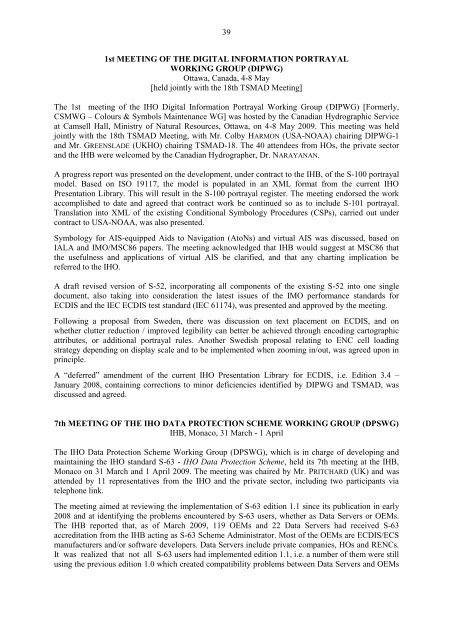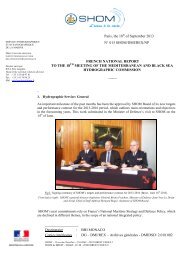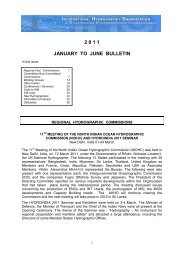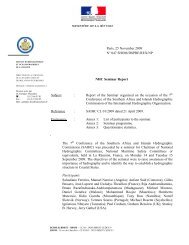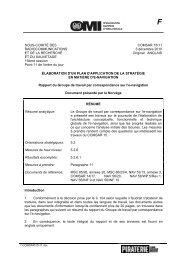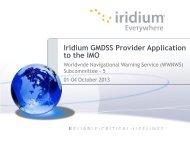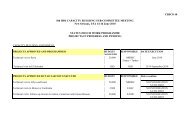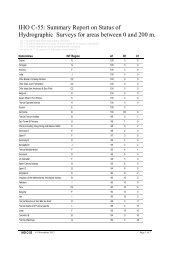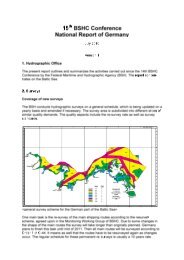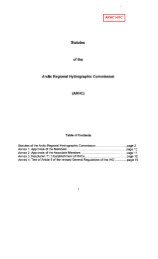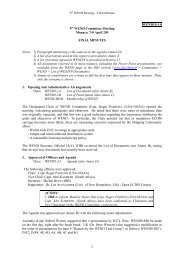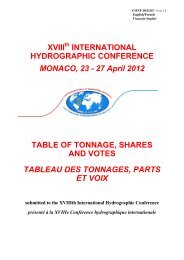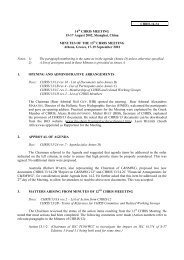Download - IHO
Download - IHO
Download - IHO
Create successful ePaper yourself
Turn your PDF publications into a flip-book with our unique Google optimized e-Paper software.
39<br />
1st MEETING OF THE DIGITAL INFORMATION PORTRAYAL<br />
WORKING GROUP (DIPWG)<br />
Ottawa, Canada, 4-8 May<br />
[held jointly with the 18th TSMAD Meeting]<br />
The 1st meeting of the <strong>IHO</strong> Digital Information Portrayal Working Group (DIPWG) [Formerly,<br />
CSMWG – Colours & Symbols Maintenance WG] was hosted by the Canadian Hydrographic Service<br />
at Camsell Hall, Ministry of Natural Resources, Ottawa, on 4-8 May 2009. This meeting was held<br />
jointly with the 18th TSMAD Meeting, with Mr. Colby HARMON (USA-NOAA) chairing DIPWG-1<br />
and Mr. GREENSLADE (UKHO) chairing TSMAD-18. The 40 attendees from HOs, the private sector<br />
and the IHB were welcomed by the Canadian Hydrographer, Dr. NARAYANAN.<br />
A progress report was presented on the development, under contract to the IHB, of the S-100 portrayal<br />
model. Based on ISO 19117, the model is populated in an XML format from the current <strong>IHO</strong><br />
Presentation Library. This will result in the S-100 portrayal register. The meeting endorsed the work<br />
accomplished to date and agreed that contract work be continued so as to include S-101 portrayal.<br />
Translation into XML of the existing Conditional Symbology Procedures (CSPs), carried out under<br />
contract to USA-NOAA, was also presented.<br />
Symbology for AIS-equipped Aids to Navigation (AtoNs) and virtual AIS was discussed, based on<br />
IALA and IMO/MSC86 papers. The meeting acknowledged that IHB would suggest at MSC86 that<br />
the usefulness and applications of virtual AIS be clarified, and that any charting implication be<br />
referred to the <strong>IHO</strong>.<br />
A draft revised version of S-52, incorporating all components of the existing S-52 into one single<br />
document, also taking into consideration the latest issues of the IMO performance standards for<br />
ECDIS and the IEC ECDIS test standard (IEC 61174), was presented and approved by the meeting.<br />
Following a proposal from Sweden, there was discussion on text placement on ECDIS, and on<br />
whether clutter reduction / improved legibility can better be achieved through encoding cartographic<br />
attributes, or additional portrayal rules. Another Swedish proposal relating to ENC cell loading<br />
strategy depending on display scale and to be implemented when zooming in/out, was agreed upon in<br />
principle.<br />
A “deferred” amendment of the current <strong>IHO</strong> Presentation Library for ECDIS, i.e. Edition 3.4 –<br />
January 2008, containing corrections to minor deficiencies identified by DIPWG and TSMAD, was<br />
discussed and agreed.<br />
7th MEETING OF THE <strong>IHO</strong> DATA PROTECTION SCHEME WORKING GROUP (DPSWG)<br />
IHB, Monaco, 31 March - 1 April<br />
The <strong>IHO</strong> Data Protection Scheme Working Group (DPSWG), which is in charge of developing and<br />
maintaining the <strong>IHO</strong> standard S-63 - <strong>IHO</strong> Data Protection Scheme, held its 7th meeting at the IHB,<br />
Monaco on 31 March and 1 April 2009. The meeting was chaired by Mr. PRITCHARD (UK) and was<br />
attended by 11 representatives from the <strong>IHO</strong> and the private sector, including two participants via<br />
telephone link.<br />
The meeting aimed at reviewing the implementation of S-63 edition 1.1 since its publication in early<br />
2008 and at identifying the problems encountered by S-63 users, whether as Data Servers or OEMs.<br />
The IHB reported that, as of March 2009, 119 OEMs and 22 Data Servers had received S-63<br />
accreditation from the IHB acting as S-63 Scheme Administrator. Most of the OEMs are ECDIS/ECS<br />
manufacturers and/or software developers. Data Servers include private companies, HOs and RENCs.<br />
It was realized that not all S-63 users had implemented edition 1.1, i.e. a number of them were still<br />
using the previous edition 1.0 which created compatibility problems between Data Servers and OEMs


